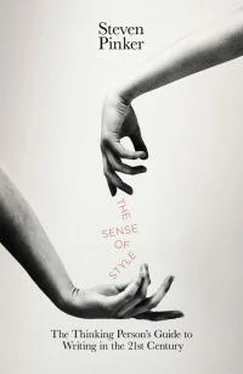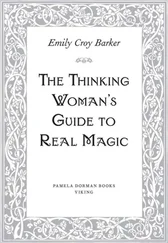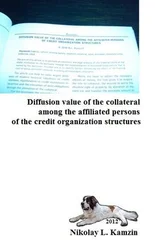sequence of tenses and other perspective shifts.A common error in student writing is to shift the tense from a main clause to a subordinate one even when they refer to the same time period. 17
She
started
panicking and got stressed out because she
doesn’t
have enough money.
She
started
panicking and got stressed out because she
didn’t
have enough money.
The new law
requires
the public school system to abandon any programs that
involved
bilingual students.
The new law
requires
the public school system to abandon any programs that
involve
bilingual students.
The incorrect versions on the left make the reader feel like she is being yanked back and forth along the time line between the moment at which the sentence was written (present) and the time of the situation being described (past). They belong to a family of “inappropriate shifts” in which the writer fails to stay put at a single vantage point but vanishes from one and pops up at another. The reader can get vertigo when the writer flip-flops within a sentence between persons (first, second, and third), voices (active and passive), or types of discourse (a direct quotation of the speaker’s exact words, usually set off with quotation marks, versus an indirect report of the gist, usually set off with that ):
Love brings out the joy in
people’s
hearts and puts a glow in
your
eyes.
Love brings out the joy in
people’s
hearts and puts a glow in
their
eyes.
People
express themselves
more offensively when their comments
are delivered
through the Internet rather than personally.
People
express themselves
more offensively when they
deliver
their comments through the Internet rather than personally.
The instructor told us
, “
Please read the next two stories before the next class
”
and
that
she might give us a quiz on them.
The instructor told us
that
we should read the next two stories before the next class and
that
she might give us a quiz on them.
Sticking to a consistent vantage point is the first step in getting the tenses in a complex story to come out right, but there’s more to it than that. A writer also has to harmonize the tenses according to a scheme called sequence of tenses, tense agreement, or backshift. Most readers sense that there is something askew in the sentences on the left:
But at some point following the shootout and car chase, the younger brother fled on foot, according to State Police, who
said
Friday night they
don’t
believe he
has
access to a car.
But at some point following the shootout and car chase, the younger brother fled on foot, according to State Police, who
said
Friday night they
didn’t
believe he
had
access to a car.
Mark Williams-Thomas, a former detective who amassed much of the evidence against Mr. Savile last year,
said
that he
is
continuing to help the police in coaxing people who might have been victimized years ago to come forward.
18
Mark Williams-Thomas, a former detective who amassed much of the evidence against Mr. Savile last year,
said
that he
was
continuing to help the police in coaxing people who might have been victimized years ago to come forward.
Security officials
said
that only some of the gunmen
are
from the Muslim Brotherhood.
Security officials
said
that only some of the gunmen
were
from the Muslim Brotherhood.
In indirect discourse in the past tense (a staple of news reporting), the tense of a verb often sounds better when it, too, is in the past tense, even though the event was in the present from the vantage point of the person speaking. 19This is clear enough in simple sentences. One would say I mentioned that I was thirsty, not I mentioned that I am thirsty, even though what I actually mentioned at the time was “I am thirsty.” Though backshifting usually occurs when someone said something in the past, it also occurs when a proposition was generally believed in the past, as in This meant that Amy was taking on too many responsibilities.
At first glance, the conditions that govern sequences of tenses seem daunting. Bernstein’s The Careful Writer, an informal style manual, takes five pages to explain fourteen rules, exceptions, and exceptions to the exceptions. Surely not even the most careful writer has learned them one by one. It’s better to understand a few principles that govern time, tense, and discourse than to try to memorize a list of regulations that are tailored to the sequence-of-tense phenomenon itself.
The first is to remember that past tense is not the same thing as past time. Recall from the discussion of if-then constructions that the past tense is used not just for events that took place in the past but for events that are remote possibilities (as in If you left tomorrow, you’d save a lot of money ). We now see that the past tense has a third meaning in English: a backshifted event in a sequence of tenses. (Though the meaning of backshifting may seem to be just past time, there are subtle semantic differences between the two.) 20
The second principle is that backshifting is not mandatory, which means that violating the sequence-of-tense rules and keeping the reported content in the present tense is not always an error. Grammarians distinguish the “attracted” or backshifted sequence, in which the tense of the embedded verb is metaphorically attracted to the tense of the verb of saying, from the “vivid,” “natural,” or “breakthrough” sequence, in which the embedded verb metaphorically breaks out of the story line of its clause and is located in the real time of the writer and reader. The vivid, nonbackshifted sequence feels more natural when the state being spoken about is not just true at the time that the speaker was speaking but true for all time, or at least indubitably true at the time that the writer is writing and the reader is reading. It would be odd to say The teacher told the class that water froze at 32 degrees Fahrenheit, which seems to suggest that perhaps it no longer does; one should violate the backshifting rule here and say The teacher told the class that water freezes at 32 degrees Fahrenheit. This leaves plenty of leeway for judgment, depending on whether the writer wishes to emphasize the continuing truth of some idea that was bruited in the past. The backshifted Simone de Beauvoir noted that women faced discrimination is neutral as to whether such discrimination is a persistent feature of our society. Simone de Beauvoir noted that women face discrimination takes the more feminist position that it is.
A third principle is that indirect discourse is not always introduced with an expression like he said that or she thought that; sometimes it is implicit in the context. Journalists get tired of repeating he said, and novelists sometimes skip it by using a technique called free indirect style, in which the narration of the author incorporates the interior monologue of a protagonist:
According to the Prime Minister, there was no cause for alarm. As long as the country kept its defense up and its alliances intact, all would be well.
Renee was getting more and more anxious. What could have happened to him? Had he leapt from the tower of Fine Hall? Was his body being pulled out of Lake Carnegie?
A writer can do the opposite, too, and interrupt his narration of an indirect discourse with an aside directed to the reader, which breaks out of the backshifted tense and into the present:
Читать дальше












